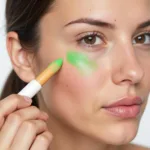Mastering eyeshadow application can transform your look, but choosing the right shades can be daunting. Understanding how to use the color wheel for eyeshadow empowers you to create stunning eye makeup, from subtle enhancements to dramatic effects. This guide will unlock the secrets of color theory and equip you with the knowledge to confidently experiment with different eyeshadow combinations. what color eyeshadow will make blue eyes pop
Understanding the Basics of the Color Wheel
The color wheel is a visual representation of colors arranged according to their relationships. It’s the foundation for understanding color harmony and how different shades interact. Primary colors (red, yellow, and blue) form the base, while secondary colors (orange, green, and violet) are created by mixing two primaries. Tertiary colors result from mixing a primary and a secondary color.
Complementary Colors: Creating Contrast and Depth
Complementary colors sit opposite each other on the color wheel. Using these contrasting shades together makes each color appear more vibrant. For instance, blue eyeshadow intensifies orange undertones in brown eyes, while purple eyeshadow makes green eyes pop. This contrast adds depth and dimension to your eye makeup.
Analogous Colors: Harmonious and Subtle Blends
Analogous colors sit next to each other on the color wheel, creating a harmonious and blended look. These combinations are perfect for a natural, everyday eye makeup look. For example, blending shades of green, blue-green, and blue creates a seamless transition and a calming effect.
Triadic Colors: Bold and Vibrant Looks
Triadic colors are evenly spaced on the color wheel, forming a triangle. This combination offers a bolder, more vibrant look. Using a triadic color scheme, such as orange, green, and violet, can create a striking and unique eye makeup look.
What Eyeshadow Colors Are Best For Your Eye Color?
Knowing your eye color is key to choosing the most flattering eyeshadow shades. Certain colors can enhance your natural eye color, making them appear brighter and more defined.
Blue Eyes
Warm tones like bronze, copper, and gold create a stunning contrast against blue eyes. what color eye shadow for blue eyes explains more about using warm eyeshadows for blue eyes. Alternatively, cool tones like silver, gray, and navy can deepen the blue hue.
Green Eyes
Purple and plum shades are particularly flattering for green eyes, as they bring out the green tones. what eyeshadow colors are best for green eyes explores this in detail. Browns and golds also complement green eyes, creating a warm and inviting look.
Brown Eyes
Brown eyes are incredibly versatile and can work with a wide range of colors. Greens, blues, and purples create a beautiful contrast, while bronze, gold, and copper enhance the warm undertones.
Hazel Eyes
Hazel eyes often contain a mix of green and brown, allowing for experimentation with both warm and cool tones. what are the best eyeshadow colors for hazel eyes gives you a detailed guide. Purples, greens, and golds can bring out the different flecks of color in hazel eyes. what color brings out green in hazel eyes focuses specifically on enhancing the green tones within hazel eyes.
Tips for Using the Color Wheel
- Start with a neutral base color to create a smooth canvas.
- Gradually build up the intensity of the colors.
- Blend carefully to avoid harsh lines.
- Consider your skin tone when choosing eyeshadow colors.
“Understanding color theory empowers you to create endless eye makeup looks,” says renowned makeup artist, Amelia Stone. “Don’t be afraid to experiment and find what works best for you.”
Conclusion
Learning how to use the color wheel for eyeshadow opens a world of possibilities for creating stunning eye makeup looks. By understanding color relationships and experimenting with different combinations, you can enhance your natural eye color, create depth and dimension, and express your unique style. So, grab your eyeshadow palette and start exploring the vibrant world of color!
FAQs
- What is the best way to blend eyeshadow? Use a fluffy blending brush in circular motions.
- Can I use the color wheel for other makeup products? Yes, the principles apply to blush, lipstick, and even foundation.
- What are neutral eyeshadow colors? Neutrals include shades like beige, brown, taupe, and black.
- How can I make my eyeshadow last longer? Use an eyeshadow primer before applying eyeshadow.
- What is the best eyeshadow brush for applying color? A flat, stiff brush is ideal for packing on color.
Need further support? Contact us 24/7: Phone: 0373298888, Email: [email protected], or visit us at 86 Cầu Giấy, Hanoi.
